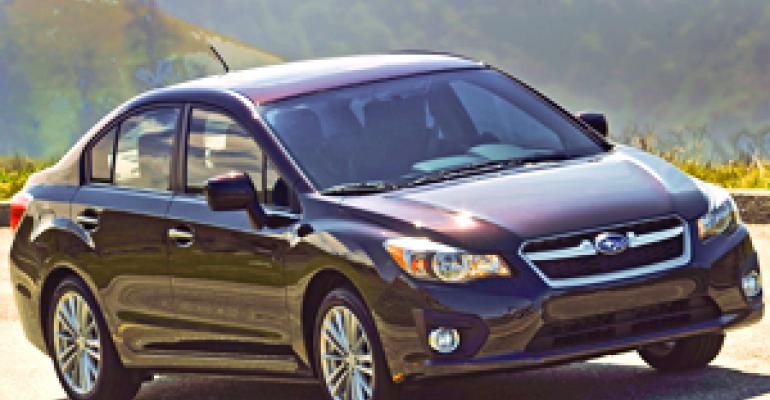
NEW HAVEN, CT – Subaru set a record in the first quarter of this year by selling 67,457 vehicles in the U.S., raising the possibility the auto maker could top 300,000 deliveries for the first time ever in 2011.
The quarterly sales figure was noteworthy because it surpassed key rivals Volkswagen and Mazda, as well as BMW, Lexus and every other luxury brand selling vehicles in the U.S., according to WardsAuto data.
But a March 11 earthquake and subsequent tsunami that damaged Japan’s automotive manufacturing operations also derailed Subaru’s sales projections. The supply of Japanese-built Impreza compact cars and Forester cross/utility vehicles became severely constrained.
“We will probably end up 2011 in the low 260,000-unit range,” H. William Cyphers III, senior vice president-sales for Subaru of America, tells WardsAuto at a press event here.
“The first quarter of this year was the best first quarter in the history of the company,” he says. “But we probably lost 30,000-40,000 cars as a result of the tsunami.”
By 2014, Subaru wants to sell 350,000 vehicles in the U.S, Cyphers says.
The auto maker has sold 3.5 million vehicles in the U.S. since 1990. Though fluctuating, the trend line generally has been upward, from 108,545 vehicles in 1990 to 200,703 in 2006 to 263,820 in 2010. Through the first eight months, Subaru has delivered 174,616 cars and CUVs.
A vital weapon in pushing Subaru over the 300,000-unit threshold is the all-new ’12 Impreza, which arrives in November as small cars are gaining popularity. The 5-door body style always has been popular with some 70% of Impreza buyers, while the remainder chose the sedan.

Cyphers expects a larger proportion of sedan buyers for the new vehicle, thanks to better styling and an attractive starting price of $17,495 with a 5-speed manual transmission mated to an all-new 148-hp 2.0L boxer engine rated at 27/36 mpg (8.7-6.5 L/100 km) city/highway.
At the fourth-generation Impreza’s unveiling in April at the New York auto show, Tom Doll, executive vice president for Subaru of America, said the new Impreza reasonably could sell in the 60,000-unit range, which would represent a 50% boost in volume.
“He’s correct, that’s not out of the realm of possibility,” Cyphers says. “But for us to do 60,000, we have to sell more sedans.”
Impreza sales were in the 20,000-unit range through the 1990s and peaked when new models arrived in 2001 (35,612 vehicles) and 2006 (41,148 vehicles). Deliveries in 2010 reached 44,395 units.
Cyphers says the pool of 625 Subaru dealers is well positioned to accommodate any volume growth.
Three years ago, Subaru had 585 U.S. showrooms, but the number has been augmented by dealers that previously had franchises aligned with downsizing Detroit auto makers.
The additional showrooms are where Subaru needs better exposure to potential customers: in the South.
“We picked up a lot of Saturn dealers in the Carolinas and throughout the South,” Cyphers says. “These are good quality dealers with great facilities, and they’ve converted them to our look. They know how to sell cars.”
He sees little need to add to the dealer pool. “It would be a modest number of open points we have. There’s no master plan to add a lot of dealers,” he says. “We’re happy with that dealer count in the 625 range, give or take a few.”
Also boosting sales prospects for Subaru are the new rear-wheel-drive BRZ sports car that goes on sale in spring, as well as the small CUV, currently known as the XV, unveiled at the recent Frankfurt auto show.
Expected to go on sale in the U.S. in 2013, the CUV is billed as a sportier version of the Outback CUV, yet smaller than the Forester.
The small CUV will have Subaru’s symmetrical all-wheel drive, which has become an important brand characteristic.
Asked if Subaru would consider a small, inexpensive front-wheel-drive car to boost the brand’s overall fuel-economy rating in the face of pending government regulations, Cyphers is quick to dismiss the notion.
“People buy our car because it’s all-wheel drive,” he says, recalling the “dark days” in the early 1990s when Subaru tried unsuccessfully to sell FWD cars. Soon after, the auto maker dedicated itself to AWD exclusivity.
“If all of a sudden you’re producing front-wheel-drive cars, then you’re going head to head with Toyota and Honda,” he says.




